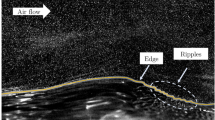Abstract
The behaviour of intermittent turbulent temperature fluxes is characterized in terms of a flux interval, defined as the time interval over which flux values are computed, and a flux threshold value. Fluxes whose magnitudes exceed the threshold value are defined as flux events while the times when the threshold is not exceeded are defined as gaps. Turbulent temperature flux data from five sites in Kansas, Utah, and Washington State, U.S.A. are examined within this descriptive framework. The turbulent event fraction fturb, the ratio of the time occupied by turbulent events to the total sampling time, is found to depend linearly on the average flux for the sampling period over a range of flux intervals, threshold values, and sampling times. As the average flux for a sampling period decreases toward zero, the median magnitude of the fluxes during the gaps also decreases but the median fluxes during the turbulent events become nearly independent of the sampling period average. A wide range of values of fturb is found for gradient Richardson numbers less than 0.3, indicating the possibility of considerable intermittency under weakly to moderately stable conditions
Similar content being viewed by others
References
Barnard, J. C.: 2000, Intermittent Turbulence in the Very Stable Boundary Layer, Ph.D. Thesis, Department of Mechanical Engineering, University of Washington, 155 pp.
Blackadar, A. K.: 1979, in J. R. Pfafflin and E. N. Ziegler (eds.), Advances in Environmental Science and Engineering, Gordon and Breech, pp. 50–85.
Coleman, G. N., Ferziger, J. H., and Spalart, P. R.: 1992, ‘Direct Simulation of the Stably Stratified Ekman Layer, J. Fluid Mech. 244, 677–712.
Coulter, R. L. and Doran, J. C.: 2002, ‘Spatial and Temporal Occurrences of Intermittent Turbulence during CASES-99’, Boundary-Layer Meteorol. 105, 329–349.
Derbyshire, S. H.: 1999, ‘Boundary-Layer Decoupling over Cold Surfaces as a Physical Boundary Instability’, Boundary-Layer Meteorol. 90, 297–325.
Doran, J. C., Fast, J. D., and Horel, J.: 1992, ‘The VTMX 2000 Campaign’, Bull. Amer. Meteorol. Soc. 83, 537–551.
Howell, J. F. and Sun, J.: 1999, ‘Surface-Layer Fluxes in Stable Conditions’, Boundary-Layer Meteorol. 90, 495–520.
Kondo, J., Kanechika, O., and Yasuda, N.: 1978, ‘Heat and Momentum Transfers under Strong Stability in the Atmospheric Surface Layer’, J. Atmos. Sci. 35, 1012–1021.
Mahrt, L.: 1999, ‘Stratified Atmospheric Boundary Layers’, Boundary-Layer Meteorol. 90, 375–396.
Mahrt, L., Sun, J., Blumen, W., Delaney, T., and Oncley, S.: 1998, ‘Nocturnal Boundary-Layer Regimes’, Boundary-Layer Meteorol. 88, 255–278.
McNider, R. T., England, D. E., Friedman, M. J., and Shi, X.: 1995, ‘Predictability of the Stable Atmospheric Boundary Layer’, J. Atmos. Sci. 52, 1602–1614.
Nappo, C. J.: 1991, ‘Sporadic Breakdowns of Stability in the PBL over Simple and Complex Terrain’, Boundary-Layer Meteorol. 54, 69–87.
Nieuwstadt, F. T. M.: 1984., ‘The Turbulent Structure of the Stable, Nocturnal Boundary Layer’, J. Atmos. Sci. 41, 2202–2216.
Pahlow, M., Parlange, M. B., and Porte-Angel, F.: 2001, ‘On Monin-Obukhov Similarity in the Stable Atmospheric Boundary Layer’, Boundary-Layer Meteorol. 99, 225–248.
Poulos, G. S., et al.: 2002, ‘CASES-99: A Comprehensive Investigation of the Stable Nocturnal Boundary Layer’, Bull. Amer. Meteorol. Soc. 83, 555–581.
ReVelle, D. O.: 1993, ‘Chaos and “Bursting” in the Planetary Boundary Layer’, J. Appl. Meteorol. 32, 1169–1180.
Soler, M. R., Infante, C., Buenestado, P., and Mahrt, K.: 2002, ‘Observations of Nocturnal Drainage Flow in a Shallow Gully’, Boundary-Layer Meteorol. 105, 253–273.
Sun, J., et al.: 2002, ‘Intermittent Turbulence Associated with a Density Current Passage in the Stable Boundary Layer’, Boundary-Layer Meteorol. 105, 199–219.
Van de Wiel, B. J. H., Ronda, R. J., Moene, A. F., DeBruin, A. R., and Holtslag, A. A. M.: 2002a, ‘Intermittent Turbulence and Oscillations in the Stable Boundary Layer over Land, Part I: A Bulk Model’, J. Atmos. Sci. 59, 942–958.
Van de Wiel, B. J. H., Moene, A. F., Ronda, R. J., DeBruin, A. R., and Holtslag, A. A. M.: 2002b, ‘Intermittent Turbulence and Oscillations in the Stable Boundary Layer over Land, Part II: A System Dynamics Approach’, J. Atmos. Sci. 59, 2567–2581.
Author information
Authors and Affiliations
Rights and permissions
About this article
Cite this article
Doran, J.C. Characteristics of Intermittent Turbulent Temperature Fluxes in Stable Conditions. Boundary-Layer Meteorology 112, 241–255 (2004). https://doi.org/10.1023/B:BOUN.0000027907.06649.d0
Issue Date:
DOI: https://doi.org/10.1023/B:BOUN.0000027907.06649.d0




